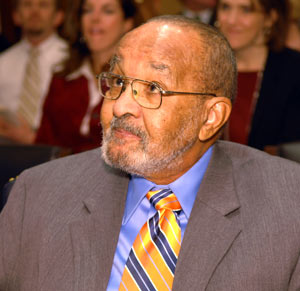Emmett Chappelle facts for kids
Quick facts for kids
Emmett W. Chappelle
|
|
|---|---|

Chappelle at the National Inventors Hall of Fame induction ceremony in 2007
|
|
| Born | October 24, 1925 |
| Died | October 14, 2019 (aged 93) |
| Nationality | American |
| Education | Phoenix College, University of California, Berkeley (B.S.), University of Washington (M.S.) |
| Known for | Biolumenescenc |
| Scientific career | |
| Fields | Biochemistry, food science, astrochemistry |
| Institutions | Meharry Medical College (Nashville, Tennessee), Stanford University, Martin Marietta Corporation, National Aeronautics and Space Administration (NASA) |
Emmett W. Chappelle (born October 24, 1925 – died October 14, 2019) was an amazing American scientist. He made important discoveries in areas like medicine, food science, and even astrochemistry, which is the study of chemicals in space. He was so good at his work that he was added to the National Inventors Hall of Fame in 2007. This was for his special work on something called bioluminescence, which is light made by living things. He was also named one of the top 100 African American scientists of the 20th Century.
Contents
Early Life
Emmett Chappelle was born in Phoenix, Arizona in 1925. His parents, Viola White Chappelle and Isom Chappelle, grew cotton and raised cattle on their farm. Because of segregation rules at the time, Emmett had to go to a separate school for Black students. He attended Phoenix Union Colored High School in Phoenix. He was the best student in his class of 25 when he graduated in 1942.
After high school, Emmett joined the army. He took some engineering classes there. He was part of the 92nd Infantry Division and served in Italy. He was hurt twice during his time in the army, but he recovered. When he came back from Italy in 1946, he went to Phoenix College. He first studied electrical engineering. Later, he changed his focus to science.
Important Discoveries
In 1950, Chappelle earned a degree in biology from the University of California, Berkeley. He then taught biochemistry at Meharry Medical College in Nashville, Tennessee, from 1950 to 1953. Even though he didn't have a graduate degree yet, he was a teacher. He then went to the University of Washington to get his master's degree in biology.
From 1955 to 1958, he worked at Stanford University. After that, he became a scientist and biochemist at the Research Institute of Advanced Studies until 1963.
Plants and Light
In 1958, Chappelle joined the Research Institute in Baltimore. This group was part of the Martin Marietta Corporation, which designed airplanes and spacecraft. There, Chappelle made a big discovery about tiny living things. He found that even single-celled organisms like algae can perform photosynthesis. This means they can turn carbon dioxide into sugar and water into oxygen. Photosynthesis is how plants make their own food using sunlight. It's the opposite of cellular respiration, which all living things use to get energy.
Exploring Space and Life
In 1963, Chappelle worked as a biochemist at Hazelton Laboratories. Later, in 1966, he joined the National Aeronautics and Space Administration (NASA). At NASA, he was an exobiologist and astrochemist. This means he looked for life beyond Earth and studied the chemistry of space objects. He helped create tools for the Viking Spacecraft. These tools were used to collect soil from the surface of Mars.
In 1977, he moved to the Goddard Space Flight Center in Greenbelt, Maryland. There, he became a remote sensing scientist. He studied natural systems to help manage the environment better.
Fireflies and Finding Life
Chappelle became very interested in bioluminescence while working on the Mars Viking spacecraft. Bioluminescence is the warm light that living things, like fireflies, can produce. He found a way to use two chemicals from fireflies, called luciferase and luciferin. When these chemicals mix with ATP (adenosine triphosphate), they give off light. ATP is like the energy storage unit found in all living cells.
This method of finding ATP can be used to detect life on other planets. It can also find tiny living things called microorganisms. Chappelle also showed that you can measure how many bacteria are in water by how much light they give off. This discovery helped scientists and doctors find small amounts of bacteria in places like urine. This could help them find bacterial infections early.
Additionally, he created a way to check how healthy plants are. He used laser-induced fluorescence to measure how much photosynthesis was happening in crops. This allowed scientists to see if plants were stressed, how fast they were growing, if they had enough water, and when they would be ready to harvest.
Chappelle retired from NASA in 2001 when he was 76 years old. He passed away in Baltimore, Maryland on October 14, 2019, at the age of 93.

